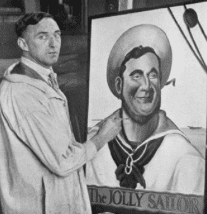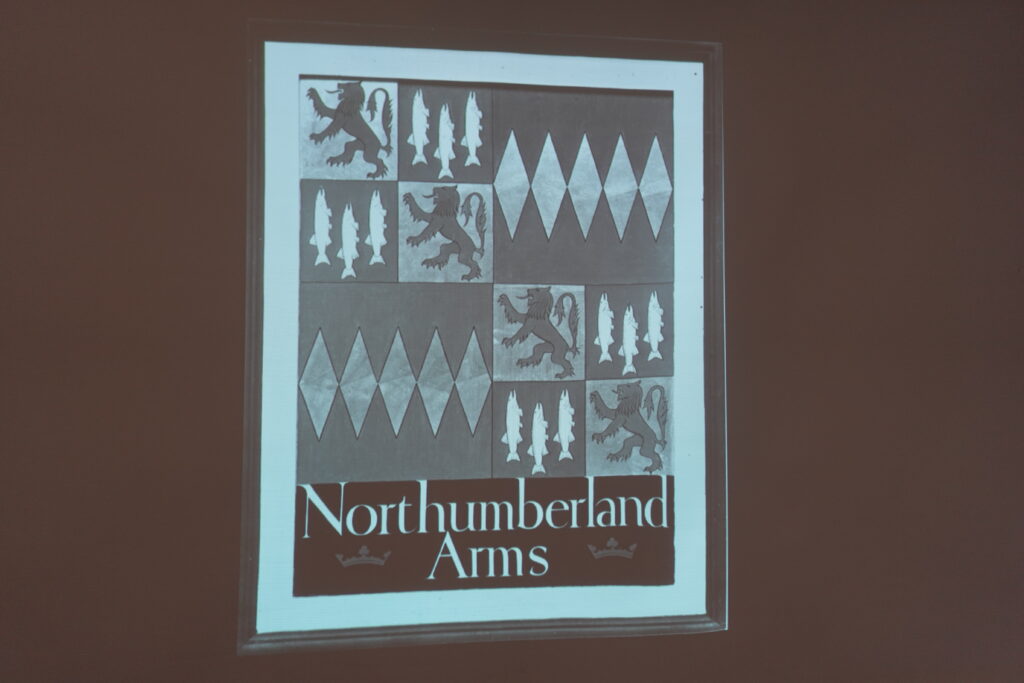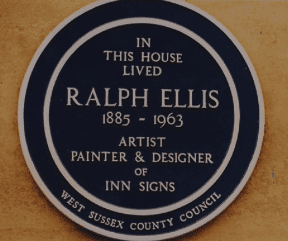We cast an Eye on Ralph Ellis, a 20th-century sign painter who specialised in pub signs.
Through the 1920s to the 1950s, Ralph Ellis’ artwork was well-known to the clientele of hundreds of pubs in Sussex, Surrey, and Hampshire. The Arundel Museum’s new exhibition highlights this exceptionally talented former resident, telling a life story that spoke of hardship, creativity and hard work.

Born in Arundel in 1885, Ralph Ellis’s early life was touched by tragedy. His father was a taxidermist with a shop in the High Street, but the family suffered a profound loss when two of Ralph’s older brothers succumbed to a Typhoid epidemic in 1890. The source of the contamination was later traced to the town pump in the High Street square.
After leaving school at 14, Ralph headed to London, where he trained in sign writing, painting, and decorating. Following a brief period in New Barnet, he settled in Bognor Regis with his wife, Gertrude Ada Seymour, where he began to build his career, selling art supplies and his own landscape paintings, particularly of the stunning South Downs.
From the battlefield to the easel
At the outbreak of World War 1, Ralph enlisted in the 7th (Service) Battalion, Royal Sussex Regiment, but his army service came to an end in 1917 when he was wounded in the arm. The wound ended his time in the army, but thankfully not his career in art.
Ralph continued his artistic education at the Slade Academy of Art, and from 1920, Ralph and Gertrude settled in Arundel. It was here that he began his most enduring work as a painter. He would often be seen cycling around Arundel with his easel, ready to capture a new view.



The cultural importance of the Pub Sign
Pub signs hold a unique place in British heritage. Historically, they were essential for navigation and identification in an era when most of the population was illiterate. The signs served as a vital visual reference and a cultural identifier for a community meeting place.
Ellis found his niche painting these pub signs, eventually becoming a prolific commercial artist. He completed over 250 signs for the brewers Henty & Constable alone, with his work spanning Sussex, Surrey, and Hampshire. His commissions extended even further afield, reaching as far as Devon, Yorkshire, and East Anglia. He even took some commissions as far afield as the US.
While many of the pubs he painted for are no longer running, some examples of his artistry still stand, such as the famous Crab and Lobster at Sidlesham.

His professional pride was evident in his meticulous approach. Ellis often visited the National Portrait Gallery in London to ensure that the depictions of various Kings and Queens on his signs were historically accurate. However, he was pragmatic about his limitations. He often found horses a struggle, and he would send these sections out to be completed by Mrs Goff in Brighton. Ellis even supplied buyers with information detailing his design process and the sign’s meaning, intending to preserve that knowledge for future generations.
He achieved national recognition when his design for the Mayflower pub was featured on a Royal Mail stamp in 2003 as part of a collection.
The Exhibition
The current exhibition at Arundel Museum, running from 20 November 2025 to 1 February 2026, offers a rich retrospective of Ellis’s life and work. It includes a detailed profile of his life, tracing the growth of his sign business, and showcasing his technical process. Visitors can view images of his local signs alongside his wider commissioned work.
The Chairman of Trustees, David Shilston, acknowledged Ellis’s importance to the town, “We are delighted to be able to shine a spotlight on such a talented former resident of Arundel, with a varied career and fascinating life story. Testament to this, is the blue plaque found in Maltravers Street, Arundel.”
Entry to the exhibition is included in the standard museum ticket, or an exhibition-only ticket is available. Details of opening times and admission can be found on the Arundel Museum website.
